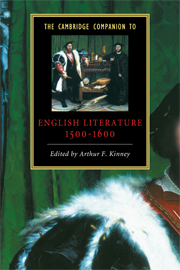Book contents
- Frontmatter
- 1 Introduction
- 2 The sixteenth century
- 3 Tudor aesthetics
- 4 Authorship and the material conditions of writing
- 5 Poetry, patronage, and the court
- 6 Religious writing
- 7 Dramatic experiments
- 8 Dramatic achievements
- 9 Lyric forms
- 10 Narrative, romance, and epic
- 11 The evolution of Tudor satire
- 12 Chronicles of private life
- 13 Popular culture in print
- 14 Rewriting the world, rewriting the body
- 15 Writing empire and nation
- Index
10 - Narrative, romance, and epic
Published online by Cambridge University Press: 28 May 2006
- Frontmatter
- 1 Introduction
- 2 The sixteenth century
- 3 Tudor aesthetics
- 4 Authorship and the material conditions of writing
- 5 Poetry, patronage, and the court
- 6 Religious writing
- 7 Dramatic experiments
- 8 Dramatic achievements
- 9 Lyric forms
- 10 Narrative, romance, and epic
- 11 The evolution of Tudor satire
- 12 Chronicles of private life
- 13 Popular culture in print
- 14 Rewriting the world, rewriting the body
- 15 Writing empire and nation
- Index
Summary
As early as 1484, William Caxton translated the fables of Aesop from the French version of Steinhowel; over the course of the following century numerous editions of Aesop and Aesopian beast-fables were to appear, in verse and prose, and in Latin as well as in English. A version in Scots by Robert Henryson was published in 1570, and one in “tru ortography” in 1585. As Annabel Patterson has shown, these fables or “apologues” proved extraordinarily adaptable to a wide array of purposes: superficially attractive in themselves as entertaining little narratives making minimal demands on a humble listener's attention span, they could be used to advance or subvert the ruling class's agenda. In the final quarter of the century, Edmund Spenser adopted the genre as a recognizable part of his repertory, and thereby signaled its place in the native literary tradition that he was advertising and “illustrating” (in the sense of Du Bellay's “Defense and Illustration” of the French language, both embodying and ennobling it, making it more lustrous).
- Type
- Chapter
- Information
- The Cambridge Companion to English Literature, 1500–1600 , pp. 200 - 219Publisher: Cambridge University PressPrint publication year: 1999

